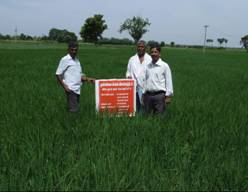 |
|||||||||||||||||||
|
|||||||||||||||||||
|
Crop Production |
Krishi Vigyan Kendra (KVK), Thiruvallur District |
Home.htm" target="_blank">Weather |
|||||||||||||||||
Management of Bacterial Leaf Streak in Rice through Technology Assessment and Refinement Rice is a major crop in Thiruvallur district of Tamil Nadu. Predominantly rice is cultivated in 1.10 lakh ha during Samba, Navarai and Sornavari seasons. In Samba season alone about 40,000 ha are being cultivated. BPT 5204 is one of the popular cultures grown extensively and approximately occupied 30% of the total samba area. Inspite of the good qualities viz., medium slender white rice, non lodging, high yield with excellent consumer preference, BPT 5204 is highly susceptible to pests and diseases. Bacterial leaf streak is one of the emerging problems in rice and especially BPT 5204 is highly susceptible. Bacterial leaf disease (Xanthomonas oryzae pv.oryzicola) has caused an annual yield loss to the tune of 80 per cent. The area affected by Bacterial leaf streak was estimated to be 10,000 ha during samba season. Apart from Thiruvallur district, the adjoining Vellore, Thiruvannamalai and Villupuram districts have also been affected by this dreadful disease. Initially farmers were not able to identify the disease and they resorted to various plant protection measures. Because of yellowing in plants the farmers applied excess dosage of nitrogen which aggravated the intensity of the disease. Krishi Vigyan Kendra, Thiruvallur took initiative to identify the disease and designed plant protection measures to arrest intensity of the disease. Then the farmers used recommended bactericide combinations viz., streptomycin sulphate 150 g / ha + Oxy tetra cyclin 150 g / ha + Copper oxy chloride 1245 g / ha due to non availability of the bactericides in the market. Krishi Vigyan Kendra Thiruvallur has done, intervention to tackle the disease in Thiruvallur District by conducting OFT’s in farmers fields. In On Farm Trial the existing practices were assessed and refinement was made by adopting the use of single formulation of bactericides viz., Streptocycline @ 45 g / ha + Copper Oxy Chloride 1250 g / ha, which gave impressive results and the per cent disease incidence was 22.6 at initial stage in the trial plot which was less than grade 3. Application of bactericide during slimy phase effectively checks the disease incidence. Further the treatment gave a yield of 5.87t/ha compared to 4.66 t/ha in farmers practice. The net return was more (Rs.28,960/-) in the improved treatment which resulted high B.C Ratio of 1.29. In the control plot the disease incidence was observed at 79.9 per cent. The refinement made in the technology was very well accepted by the farmers by visual observation, farmer’s group discussion and interactive meetings and also through mass media. The farmers themselves organized small gatherings and explained in detail about the experience they derived from the demonstrations. Thus the farmers of Vishnuvakkam and R.R.Kandigai villages paved the way for horizontal spread of newer intervention to the fellow farmers of Thiruvallur district. Timely prevention of bacterial leaf streak resulted the increased yield and marketability among the traders. Popularization of Hybrid rice CoRH 3 India has attained self sufficiency in rice production and a quantity of 150 m.t. has been aimed during 2020 to meet the requirements of growing population. With the available land and water resources, increased production is the need of the hour. Tamil Nadu Agricultural University, Coimbatore released rice hybrid CoRH 3 in 2006 and it is preferred by the Western districts of Tamil Nadu for cultivation. To popularize the hybrid in Thiruvallur District, Front Line Demonstration was conducted during Navarai 2008-09.
Thiru. K. Bakthavatchalam of Koyampakkam village raised Front Line Demonstration on hybrid rice CoRH 3 along with ADT 43 as normal practice and recorded the maximum grain yield of 6788 kg/ha obtaining a n As the farmer reaped high returns, a field day was conducted at Koyampakkam village to popularize the rice hybrid among the rice growing farmers. The successful performance of the hybrid rice CoRH 3 was visualized by the farmers and it motivated many farmers in Koyampakkam and near by villages to adopt hybrid rice cultivation. Among them, 35 farmers have raised CoRH 3 each in one acre during Sornavari 2009 and obtained an average yield of 7 tons / ha Feed back from the farmers
|
|||||||||||||||||||
Special Technologies |
|||||||||||||||||||
 |
|||||||||||||||||||
Home | About Us | Success Stories | Farmers' Association | Farmers' Innovation | Publications | FAQs | Contact
© 2013 TNAU. All Rights Reserved. |
|||||||||||||||||||
 et return of Rs. 36822 per hectare. Convinced by the performance of CoRH 3 in FLD Thiru.K.Bakthavatchalam had raised CoRH 3 rice hybrid in 2.0 ha during Sornavari 2009. He has obtained a grain yield of 7056 kg/ha which contributed to a net income of Rs.39,006 per hectare.
et return of Rs. 36822 per hectare. Convinced by the performance of CoRH 3 in FLD Thiru.K.Bakthavatchalam had raised CoRH 3 rice hybrid in 2.0 ha during Sornavari 2009. He has obtained a grain yield of 7056 kg/ha which contributed to a net income of Rs.39,006 per hectare.